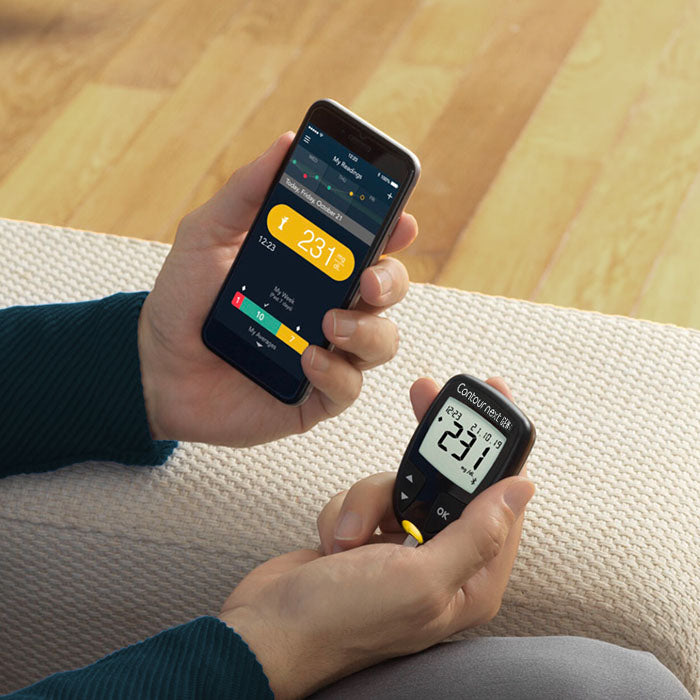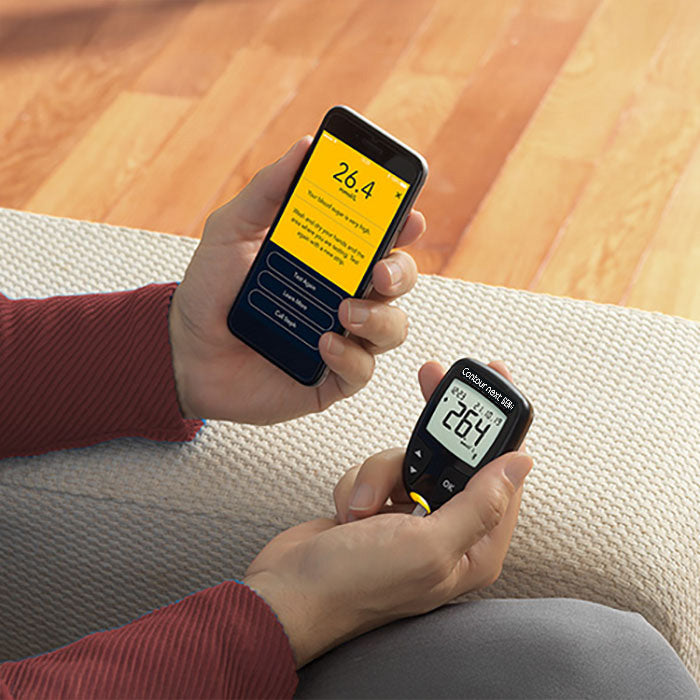Managing Hypoglycemia and Hyperglycemia
Understanding the differences between hypoglycemia vs. hyperglycemia, risks of blood sugar imbalance, and blood sugar control strategies, such as what to eat for low blood sugar, is important for people living with diabetes.

Name for your product
- Regular price
- $19.99
- Sale price
- $19.99
- Regular price
-

Hypoglycemia vs. Hyperglycemia
Hypoglycemia, or low blood sugar, is defined as blood sugar levels below 70 mg/dL (3.9 mmol/l). A blood glucose level of below 54 mg/dL indicates level 2 or severe hypoglycemia.7
Hyperglycemia, or high blood sugar, is defined as levels at or above 180 mg/dL (7.8 mmol/). "mg/dL" stands for milligrams per deciliter and is a way of measuring how much of a substance (in this case, a form of blood sugar called glucose) is found in your blood.7

Causes of Hypoglycemia
Potential causes of hypoglycemia include:3
- Increased physical activity
- Not eating on time or eating less than you should have
- Alcohol consumption
- Illness

Causes of Hyperglycemia
Hyperglycemia may be the result of diet, physical activity, and medication imbalance. High blood sugar symptoms may also happen when you are sick or stressed.3

Hypoglycemia Signs and Symptoms
Hypoglycemia symptoms can be physical and neurological. Common signs include:2
- Physical symptoms: Paleness, shakiness, sweating, dizziness or lightheadedness, tingling on your face, irregular heartbeat, nausea, and fatigue
- Neurological symptoms: Headache, difficulty concentrating, irritability or anxiety
Severe hypoglycemia can lead to confusion, poor coordination, slurred speech, vision problems, and even nightmares.2 Recognizing the signs of hypoglycemia early is key to avoid worsening symptoms.

Hyperglycemia Signs and Symptoms
Unlike symptoms of hypoglycemia, symptoms of hyperglycemia may not be as obvious, such as frequent urination, increased thirst, or blurred vision.1
As severity increases, symptoms include dry mouth, abdominal pain, nausea/vomiting, diarrhea, shortness of breath, confusion, or loss of consciousness.
Sometimes, hyperglycemia signs can be unusual, like fruity-smelling breath.1 If you are concerned about any of these symptoms, you should measure your blood glucose and follow your healthcare provider instructions.

Can Hypoglycemia cause Seizures and Convulsions?
Unlike common signs of low blood sugar such as shakiness, sweating, or irritability, severe hypoglycemia can trigger seizures or convulsions. When blood sugar levels drop too low, the brain is deprived of its essential fuel, leading to abnormal electrical activity and seizures. This is a particular concern for newborns and young children who have high energy needs, as well as for adults with diabetes who experience unpredictable blood sugar swings.6
Severe hypoglycemia can present with neuroglycopenic symptoms like confusion. and behavior changes, which may quickly progress to seizures. Prolonged or recurrent low blood sugar can also cause lasting brain changes that increase the risk for long-term neurological damage. Recognizing the warning signs and managing low blood sugar promptly is essential to prevent chronic complications.6
If you or a loved one experiences symptoms such as sudden confusion, loss of consciousness, or unexplained convulsions during a low blood sugar episode, seek emergency care immediately. The CONTOUR®NEXT GEN Blood Glucose Monitoring System can help monitor your blood sugar levels for any situation that may arise.
Blood sugar drops can be life-threatening, so it is important to follow up with your healthcare provider for ongoing management.6
Help monitor blood sugar levels with the CONTOUR®NEXT GEN meter
Recognizing the distinctions between hypoglycemia vs hyperglycemia is a key part of taking charge of your diabetes, with a highly accurate blood glucose monitoring systems playing an essential role. Using the CONTOUR®NEXT GEN blood glucose meter can help maintain balanced blood sugar levels, aiding in the effective management of both hypoglycemia and hyperglycemia.
Explore purchasing options for all Blood Glucose Monitoring Systems
Explore purchasing options for all Blood Glucose Test Strips
Explore purchasing options for all CONTOUR®NEXT Bundles
Explore purchasing options for all Complementary Diabetes Products
Explore purchasing options for KETOSTIX® and Other Diabetes Testing Supplies
References:
- Mayo Clinic Staff. Hyperglycemia. Mayo Clinic. Published July 21, 2023. Accessed November 14, 2024. Available from: https://www.mayoclinic.org/diseases- conditions/hyperglycemia/symptoms-causes/syc-20373631.
- Mayo Clinic Staff. Hypoglycemia. Mayo Clinic. Published June 18, 2023. Accessed November 14, 2024. Available from: https://www.mayoclinic.org/diseases- conditions/hypoglycemia/symptoms-causes/syc-20373685.
- Diabetes Canada. The lows and highs of blood sugar. Diabetes Canada. Accessed December 2, 2024. Available from https://diabetes.ca/resources/tools---resources/lows-and-highs-of-blood- sugar.
- Diabetes Canada. Chapter 14: Hyperglycemic emergencies in adults. In: Diabetes Canada Clinical Practice Guidelines. Diabetes Canada. Accessed December 2, 2024. Available from https://www.diabetes.ca/health-care-providers/clinical-practice-guidelines/chapter-14#panel-tab_FullText.
- Diabetes Canada. Chapter 15: Hypoglycemia. In: Diabetes Canada Clinical Practice Guidelines. Diabetes Canada. Accessed December 2, 2024. Available from https://www.diabetes.ca/health- care-providers/clinical-practice-guidelines/chapter-15#panel-tab_FullText.
- Bartolini E, Ferrari AR, Fiori S, Della Vecchia S. Glycaemic Imbalances in Seizures and Epilepsy of Paediatric Age: A Literature Review. J Clin Med. 2023 Mar 29;12(7):2580. doi: 10.3390/jcm12072580. PMID: 37048663; PMCID: PMC10095009.
- InformedHealth.org [Internet]. Cologne, Germany: Institute for Quality and Efficiency in Health Care (IQWIG); 2006-. Type 1 diabetes: Learn More - Hyperglycemia and hypoglycemia in type 1 diabetes. [Updated 2021 Dec 8]. Available from: https://www.ncbi.nlm.nih.gov/books/NBK279340/
- CONTOUR NEXT BGMS User Guide, Rev. 03/21.


